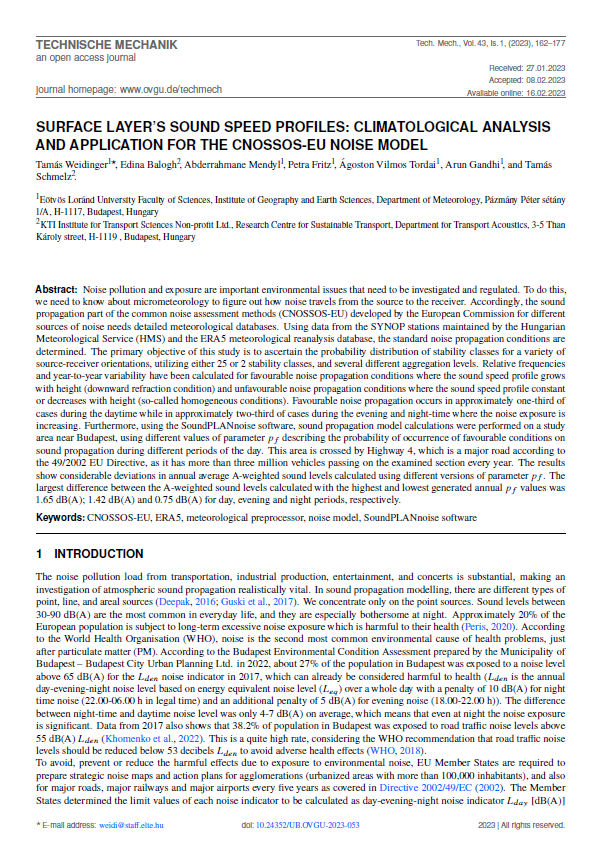SURFACE LAYER’S SOUND SPEED PROFILES: CLIMATOLOGICAL ANALYSIS AND APPLICATION FOR THE CNOSSOS-EU NOISE MODEL
DOI:
https://doi.org/10.24352/UB.OVGU-2023-053Keywords:
CNOSSOS-EU, ERA5, meteorological preprocessor, noise model, SoundPLANnoise softwareAbstract
Noise pollution and exposure are important environmental issues that need to be investigated and regulated. To do this,
we need to know about micrometeorology to figure out how noise travels from the source to the receiver. Accordingly, the sound propagation part of the common noise assessment methods (CNOSSOS-EU) developed by the European Commission for different sources of noise needs detailed meteorological databases. Using data from the SYNOP stations maintained by the Hungarian Meteorological Service (HMS) and the ERA5 meteorological reanalysis database, the standard noise propagation conditions are determined. The primary objective of this study is to ascertain the probability distribution of stability classes for a variety of source-receiver orientations, utilizing either 25 or 2 stability classes, and several different aggregation levels. Relative frequencies and year-to-year variability have been calculated for favourable noise propagation conditions where the sound speed profile grows with height (downward refraction condition) and unfavourable noise propagation conditions where the sound speed profile constant or decreases with height (so-called homogeneous conditions). Favourable noise propagation occurs in approximately one-third of cases during the daytime while in approximately two-third of cases during the evening and night-time where the noise exposure is increasing. Furthermore, using the SoundPLANnoise software, sound propagation model calculations were performed on a study area near Budapest, using different values of parameter pf describing the probability of occurrence of favourable conditions on sound propagation during different periods of the day. This area is crossed by Highway 4, which is a major road according to the 49/2002 EU Directive, as it has more than three million vehicles passing on the examined section every year. The results show considerable deviations in annual average A-weighted sound levels calculated using different versions of parameter pf. The largest difference between the A-weighted sound levels calculated with the highest and lowest generated annual pf values was 1.65 dB(A); 1.42 dB(A) and 0.75 dB(A) for day, evening and night periods, respectively.

Downloads
Published
How to Cite
Issue
Section
License
Copyright (c) 2023 Tamás Weidinger, Edina Balogh, Abderrahmane Mendyl, Petra Fritz, Ágoston Vilmos Tordai, Arun Gandhi, Tamás Schmelz

This work is licensed under a Creative Commons Attribution-ShareAlike 4.0 International License.




